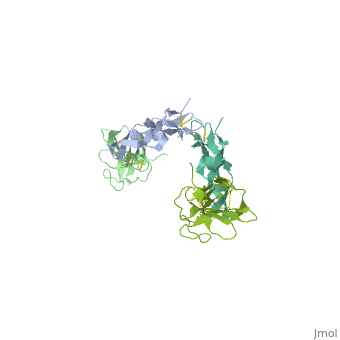The TGF beta superfamily of ligands
Bone morphogenetic protein
Bone morphogenetic protein
BMP-7 see Student Projects for UMass Chemistry 423 Spring 2012-4.
Bone morphogenetic protein 9
Bone morphogenetic protein 3D structure
TGF-β receptors (Transforming Growth Factor) (TGFR) are serine/threonine kinase receptors. They are involved in paracrine signaling and are found in many types of tissue. TGF-β ligands include bone morphogenetic proteins, growth and initiation factors, anti-Mullerian hormone, activin, nodal TGF-β[1]. There are 3 types of TGFR:
- TGFR I forms heteromeric complex with TGFR II when it is bound to TGF-β. The complex transduces the TGF-β signal from the cell surface to the cytoplasm by phosphorylating proteins which regulate the transcription of genes related to cell proliferation. TGFR I has high affinity for TGF-β1 and low affinity for TGF-β2.
- TGFR II is a tumor suppressor transmembrane protein. TGFR II has high affinity for TGF-β1 and low affinity for TGF-β2.
- TGFR III is a cell-surface chondroitin sulfate / heparin sulfate proteoglycan. It acts as a reservoir of ligand for TGFRs. TGFR III has high affinity for TGF-β1, TGF-β2 and TGF-β1.2.
